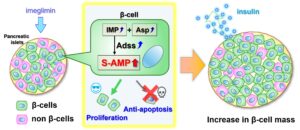Ryota Inoue 1, Takahiro Tsuno 1, Takashi Nishimura 2, Setsuko Fukushima 1, Sayaka Hirai 3, Masayuki Shimoda 3, Yuto Yoshinari 2, Chisato Sakai 1, Tatsuya Kin 4, Euodia Xi Hui Lim 5,6 Adrian Kee Keong Teo 5,6, Shinichi Matsumoto 3, A. M. James Shapiro 4, Jun Shirakawa 1,7,* (1. Laboratory of Diabetes and Metabolic Disorders, Institute for Molecular and Cellular Regulation (IMCR), Gunma University, Japan; 2. Department of Endocrinology and Metabolism, Graduate School of Medicine, Yokohama City University, Yokohama, Japan; 3. Research Center for Experimental Modeling of Human Disease, Kanazawa University, Kanazawa, Japan; 4. Clinical Islet Laboratory and Clinical Islet Transplant Program, University of Alberta, Edmonton, AB T6G 2C8, Canada; 5. Life Science Center for Survival Dynamics, Tsukuba Advanced Research Alliance (TARA), University of Tsukuba, Tsukuba, Japan; *Corresponding Author)
About
Imeglimin is a drug for type 2 diabetes that promotes β-cell proliferation; however, the detailed underlying molecular mechanism remains unclear. We investigated metabolites in pancreatic islets after imeglimin treatment via liquid chromatography with tandem mass spectrometry (LC–MS). Treatment with imeglimin for 24 hours increased adenylosuccinate (S-AMP), produced by adenylosuccinate synthase (ADSS) from inosine monophosphate (IMP) and aspartate in mouse islets. The levels of IMP and aspartate and both the mRNA and protein levels of adenylosuccinate synthase (Adss) were elevated following imeglimin treatment in islets. Alanosine, an inhibitor of ADSS, suppressed imeglimin-induced β-cell proliferation in mouse islets, human islets, human pluripotent stem cell-derived β-like cells, and porcine islets. These data suggested that treatment with imeglimin promotes β-cell proliferation partly through an increase in S-AMP production.
Paper information
Ryota Inoue 1, Takahiro Tsuno 1, Takashi Nishimura 2, Setsuko Fukushima 1, Sayaka Hirai 3, Masayuki Shimoda 3, Yuto Yoshinari 2, Chisato Sakai 1, Tatsuya Kin 4, Euodia Xi Hui Lim 5,6 Adrian Kee Keong Teo 5,6, Shinichi Matsumoto 3, A. M. James Shapiro 4, Jun Shirakawa 1,7,*
(1. Laboratory of Diabetes and Metabolic Disorders, Institute for Molecular and Cellular Regulation (IMCR), Gunma University, Japan; 2. Department of Endocrinology and Metabolism, Graduate School of Medicine, Yokohama City University, Yokohama, Japan; 3. Research Center for Experimental Modeling of Human Disease, Kanazawa University, Kanazawa, Japan; 4. Clinical Islet Laboratory and Clinical Islet Transplant Program, University of Alberta, Edmonton, AB T6G 2C8, Canada; 5. Life Science Center for Survival Dynamics, Tsukuba Advanced Research Alliance (TARA), University of Tsukuba, Tsukuba, Japan; *Corresponding Author)
Online URL
https://pubmed.ncbi.nlm.nih.gov/40638403/








